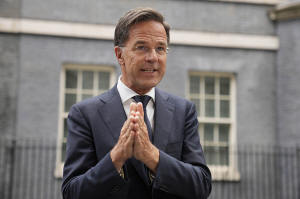NATO will start an annual nuclear exercise as Russia threatens Ukraine's
Western backers
 Send a link to a friend
Send a link to a friend
 [October 10, 2024]
By LORNE COOK [October 10, 2024]
By LORNE COOK
BRUSSELS (AP) — NATO will hold a long-planned major nuclear exercise
next week, the alliance’s chief said Thursday, a few weeks after
President Vladimir Putin announced changes to Russia’s nuclear doctrine
to discourage Ukraine’s Western allies from supporting attacks on his
country.
The “Steadfast Noon” exercise starts on Monday and will run for about
two weeks. It will be led by Belgium and the Netherlands, use eight
military bases and involve 2,000 personnel and 60 aircraft from 13
nations. The exercise has been held at roughly the same time each year
for over a decade.
Bomber aircraft and fighter jets that can carry nuclear warheads are
taking part. No live munitions are used. The bulk of the exercise is
being held around 900 kilometers (560 miles) from Russia in the North
Sea. Moscow has been informed about the drills, NATO officials say.
"In an uncertain world, it is vital that we test our defence and that we
strengthen our defence so that our adversaries know that NATO is ready
and is able to respond to any threat,” new NATO Secretary-General Mark
Rutte told reporters in London.
The United States and the U.K., with their strategic nuclear forces, are
key to NATO’s security deterrence. France also has nuclear weapons but
is not a part of the organization’s nuclear planning group.
Angus Lapsley, NATO Assistant Secretary General for Defense Policy and
Planning, said the exercise is aimed at proving that the alliance’s
ability to counter any threat to its 32 member countries is credible and
something that “any adversary would need to take extremely seriously
indeed.”
Lapsley said that NATO has been monitoring the emergence of North Korea
as a nuclear power, the rapid expansion of China’s nuclear capabilities
and developments in Iran — “but obviously what worries us most is
Russia.”

He said Moscow has been investing in its nuclear forces “with
accelerating intensity” over the last two years, and that it is
“introducing lots of novel systems and putting more emphasis on
investment in short and intermediate range weapons systems.”
[to top of second column]
|

NATO Secretary General Mark Rutte speaks to the media after a
meeting with Britain's Prime Minister Keir Starmer and Ukrainian
President Volodymyr Zelenskyy at 10 Downing Street in London,
Thursday, Oct. 10, 2024.(AP Photo/Kin Cheung)

Lapsley noted that Moscow has recently been “talking an awful lot
about their nuclear doctrine and how that may or not be evolving.”
He said that it appears to be “a pretty clear attempt to influence
us” when it comes to support for Ukraine.
Putin and other Kremlin voices have frequently threatened the West
with Russia’s nuclear arsenal. In a strong, new warning late last
month, Putin said that a conventional attack on Russia by any
country with the support of a nuclear power will be considered a
joint attack.
The threat was meant to dissuade the U.S. and its allies from
allowing Ukraine to strike into Russian territory with longer-range
weapons and appears to significantly lower the threshold for the
possible use of Russia’s nuclear arsenal. But NATO has not seen any
real change in Moscow’s nuclear posture.
Taking office on Oct. 1, Rutte stressed that while Putin’s nuclear
rhetoric was “reckless and irresponsible,” there was no evidence of
any imminent threat of nuclear weapons being used.
Rutte said it's important to just leave Putin to “talk about his
nuclear arsenal. He wants us also to discuss his nuclear arsenal,
and I think we shouldn’t.”
At the same time, Rutte said, giving in to any threat “would set a
precedent that using military force allows a country to get what it
wants, and we cannot do that.”
Daniel Bunch, the Chief of Nuclear Operations at NATO’s military
headquarters, said that while dozens of aircraft are involved, a lot
of the drill is happening behind the scenes.
“Under Steadfast Noon we seek to stress the overall system; put
people in tough positions, high operations tempos,” Bunch said. He
said that the challenge of coordinating things “literally down to
the minute of when we would put a weapon onto a target is a very
complex activity.”
All contents © copyright 2024 Associated Press. All rights reserved |